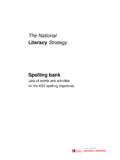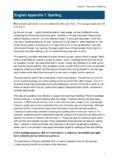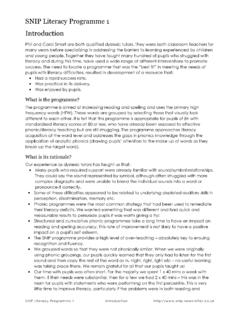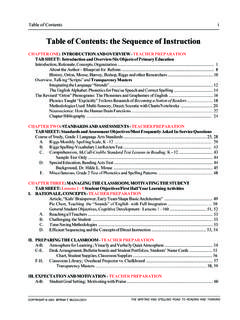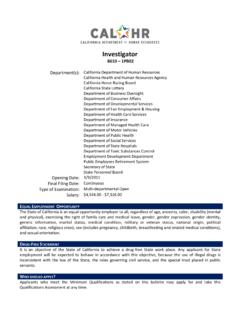Transcription of Key objectives bank: Year 7 - UCL Institute of …
1 GuidanceCurriculum, Examinationand AssessmentHeads ofDepartments &Teachers ofYear 7 pupilsStatus: RecommendedDate of issue: 11/02 Ref: DfES 0207/2002 Key objectives bank : year 7 PHOTO REDACTED DUE TO THIRD PARTY RIGHTS OR OTHER LEGAL ISSUES Key objectives bank : year 7 AcknowledgementsText 1997 Henrietta BranfordQuotes from Fire, Bed and Boneby Henrietta BranfordReproduced by Permissioon of Walker Books Ltd, London, SE11 5 HJContentsPageIntroduction1 Teaching word level objectives2 Word level objective 1: Vowel choices3 Word level objective 8: Personal spelling6 Word level objective 14: Word meaning in context10 Teaching sentence level objectives13 Sentence level objective 1: 15 Subordinate clauses: type, functions, positioningSentence level objective 8: Starting paragraphs19 Sentence level objective 13: Stylistic conventions of non-fiction22 Sentence level objective 15: Vary formality25 Teaching reading objectives28 Reading objective 2: Extract information29 Reading objective 8: Infer and deduce33 Reading objective 12: Character, setting and mood36 Reading objective 17: Independent reading40 Teaching writing objectives44 Writing objective 1.
2 Drafting process45 Writing objective 5: Story structure50 Writing objective 10: Organise texts appropriately53 Writing objective 15: Express a view56 Writing objective 19: Reflective writing60 Teaching speaking and listening objectives63 Speaking and listening objective 1: Clarify through talk65 Speaking and listening objective 6: Recall main points68 Speaking and listening objective 10: Report main points72 Speaking and listening objective 15: Explore in role76ivKey objectives bank : year 7 IntroductionKey objectivesIn each sub-section of the Framework for teaching English: years 7 , 8 and 9(DfEE 0019/2001), certain key objectives have been identified in boldfaceprint.
3 These objectives are key because they signify skills or understandingwhich are crucial to pupils language development. They are challenging for the age group, and selected because they are important markers ofprogress. They are not the only signs of progress, but they are critical have been selected to help teachers in defining targets and as a focusfor the three years of the key stage, the objectives trace a critical path ofprogress for pupils. In some cases, the objectives address the same developingskills over three years, but sometimes the focus changes. This reflects the waycertain strands rise in significance whilst others are secured and thereforeassume less prominence.
4 Using this bankThis bank provides information and guidance to help teachers to:utranslate numerical targets into curricular objectives , defining what pupilsneed to do to achieve the standards expected;ufocus teaching on those things that will move pupils on;uinform assessment tasks, so that critical indicators of progress are key objective is allocated its own pages of guidance, but this does notimply that teachers should approach them in isolation or teach them in areductive way. objectives benefit from being taught explicitly and from beingidentified and deployed in context. Planning should draw together objectivesfrom word, sentence and text level, and teachers are encouraged to find waysof clustering together complementary word level objectivesThis section contains a bank of teaching ideas to help the teaching of keyword level objectives in Key Stage 3.
5 They are designed to support teachersin teaching spelling and vocabulary systematically and enjoyably, in waysthat help pupils to develop a positive perspective on themselves as spellersand in the extension of their matters to readers and it matters to writers because it is part of theprocess of making meaning through the written word. Competence in spellingreleases the creativity of the writer. Young writers need to be so confidentabout their spelling that they can concentrate on composing ideas and makingstylistic choices at word and sentence level that reflect the purpose and thecontext of their spelling is more regular than it may seem: there are fewer than 500wholly irregular words in modern English, but some are words that we use veryfrequently.
6 Since English spelling is more than 80% predictable, it makes senseto teach spelling systematically, not just incidentally. David Crystal makes thatpoint very clearly in his Cambridge Encyclopedia of the English Language*: If the spelling system contains such regularity, why is there a problem? Theanswer is complex, but a major factor is that children are rarely taught how tospell. They are made to learn spellings by heart, and are rigorously tested onthem, but few attempts are made to explain what it is they have learned. Theyare not generally told why spellings are as they are, or about how these spellingsrelate to the way words are pronounced.
7 Without such perspective, spellingbecomes a vast, boring and time-consuming memory task. (p. 272)It is important to use the bank of ideas selectively since pupils will have metmany of the objectives before: less confident pupils may need reinforcementand consolidation, while more able pupils should be encouraged to pursueinvestigations which develop their appreciation of the origins and patternsof English are explored through a number of activities and are approachedfrom different angles in a deliberate attempt to embed understanding. ResourcesuLiteracy across the curriculum training file, DfEE 0235/2001uEnglish department training 2001, DfEE 0234/2001uYear 7 spelling bank , DfEE 0047/2001uLiteracy Progress Unit: Spelling, DfEE 0475/20012* Reference: D.
8 Crystal The Cambridge Encyclopedia of the English University Press, STAGE 3 NATIONAL STRATEGY KEY objectives bank : year 7 WORD LEVELW1 Vowel choicesAbout this objectiveThis objective aims to equip pupils with knowledge and understanding thatwill enable them to make the correct vowel choices in their own spelling. Theyshould be aware of the most likely spelling patterns and combinations, so thatthe choices they make are informed ones. They should be aware that somevowels are hidden , because they are not clearly pronounced when the word isspoken, and they should develop strategies for remembering these should be secure in the conventions of adding vowel suffixes and knowthe rules about the soft c.
9 This objective should be taught in a number of ways to ensure regular practiceand reinforcement once it has been understood. It will be embedded inschemes of work for regular reviewing, and also embedded in whole-schoolpractice for marking written work. Certain parts of the objective may requiremore sustained focus than others. Continued difficulty with the first part mayrequire further intervention on each convention there is the opportunity to differentiate with exampleswhich are more challenging ( ). Guided reading andwriting sessions will provide the opportunity to develop further the practicewith a group of pupils who share the same spelling needs.
10 This will lead to thedevelopment of conscious and self-aware spellers by the setting up of personaltargets and lists, and the practice of peer testing and to teachuThe most likely ways of spelling the long vowel phonemesuStrategies for spelling unstressed vowels in polysyllabic wordsuThe convention of when to double consonants before adding suffixesuThe rule about when the cis softenedTeaching approachesuIntroducing and investigating the objective Word sort (1): ask pupils to put a bank of words on cards into groupsaccording to the spelling of the long aphoneme. Ask them to identifythe most likely spellings of this phoneme (i) at the end of words, (ii) inthe middle of words and (iii) in combination with different :matelatedaywaiteightestatefailslatertra ilssnailwaitingagessafefrustratefategrad esstayedlaysmakesplatebakedlakestateplay arcadechangesayragecaseaches Word sort (2): ask pupils to sort the following words according to spellingpattern to discover the most common spelling patterns for long iand ephonemes when followed by the.










